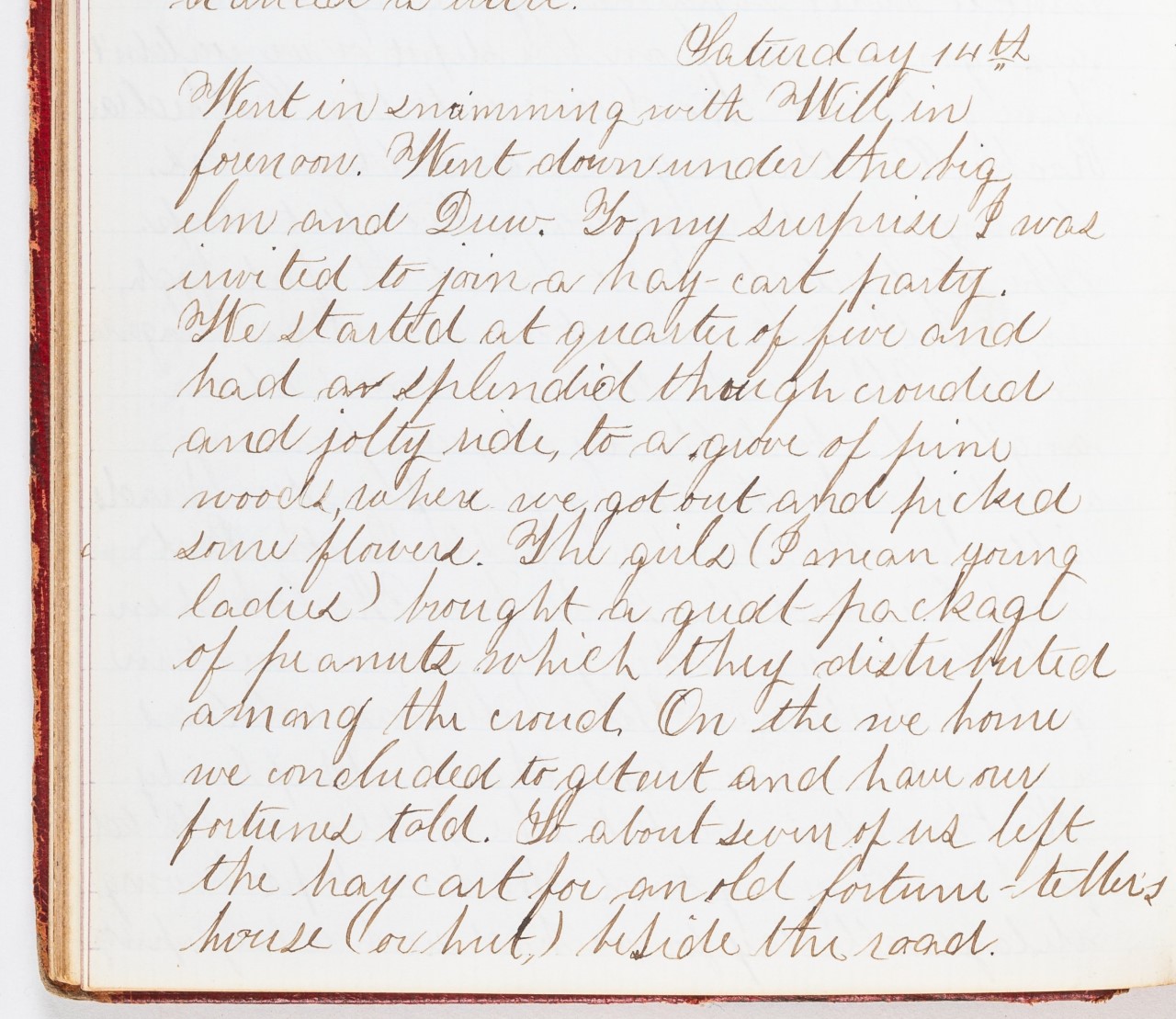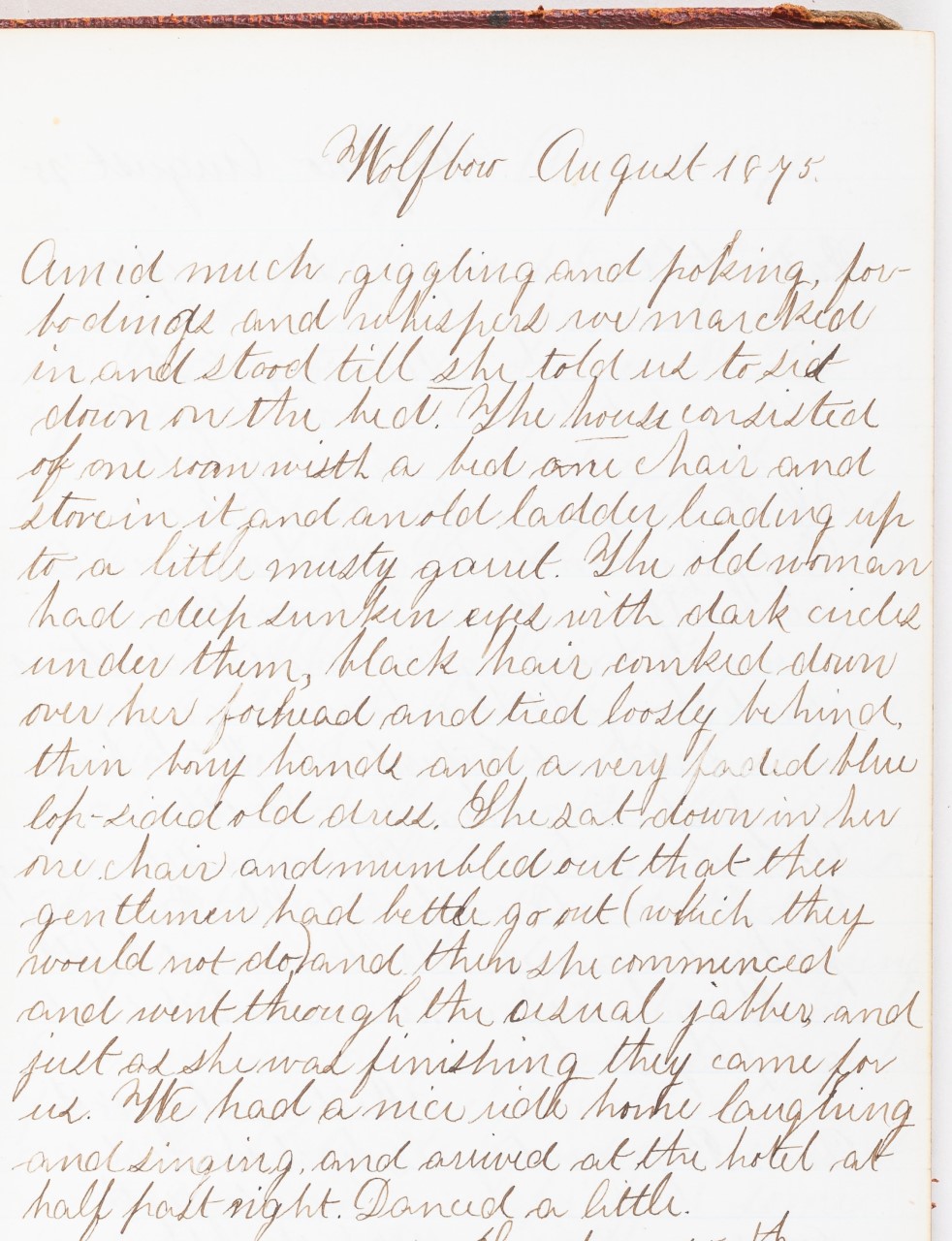
Marion ("Minnie") Boyd Allen (1862-1941) was born in Boston, Massachusetts, on October 23, 1862. When she was older she studied at the art school of the Boston Museum of Fine Art and became a prominent painter. When she was in her 60s, she even traveled west to paint the Grand Canyon!
Minnie kept this diary from age 12 to 14 from June 15, 1875, right before a three-month summer break, to December 24, 1876, while she lived in Boston with her parents and brother. Minnie wrote about writing in her journal; going to school, church, Sunday school, parties, plays, the circus, baseball games, and the dentist; reading, being read to, and reading aloud to others; knitting, drawing, sketching, painting, and inking; having her picture taken; making molasses candy, peppermints, enigmas, poetry, jack o'lanterns, valentines, and Christmas presents; dancing; singing; riding; taking piano lessons; collecting mosses, rocks, birds eggs, and wood; playing card games such as pitch, euchre, sancho pedro, bezique, whist, and solitaire; and playing other games such as checkers, chess, backgammon, billiards, croquet, flower, consequences, I spy, tic tac toe, cat's cradle, hide and go seek, last look, last tag, jump rope, gossip, criticism, traveller, jackstraws, marbles, tops, forfeits, post office, magic music, spin the cover, menagerie, bowling, heads and tails, charades, and stagecoach; performing Cinderella at a Thanksgiving celebration. Mentions of all these activities may be found in the transcription of Minnie’s diary.
Minnie spent a lot of time at "Hillside" (most likely her grandparents’ place in Melrose, Massachusetts) where she spent a lot of time reading, playing card games, and playing with other young people named Katie, Milly, Bertie, and Annie. Each year Minnie travelled with her family to a hotel at Wolfeboro, N.H. (on the shore of Lake Winnipesaukee) for the months of July and August. However, in 1876, Minnie went first to a camp on Umbagog Lake on the Maine-New Hampshire border before travelling to Wolfeboro. At Wolfeboro, she went fishing, had swimming and rowing lessons, yachted, hiked and climbed, and played games. She even visited a fortune-teller on August 14, 1875:
Went in swimming with Will in forenoon. Went down under the big elm and Drew. To my surprise I was invited to join a hay cart party. We started at a quarter of five and had a splendid though crowded and jolty ride, to a grove of pine woods, where we got out and picked some flowers. The girls (I mean young ladies) brought a good package of peanuts which they distributed among the crowd. On the we [i.e., way] home we concluded to get out and have our fortunes told. So about seven of us left the hay cart for an old fortune-teller's house (or hut) beside the road. Amid much giggling and poking, forbodings and whispers we marched in and stood till she told us to sit down on the bed. The house consisted of one room with a bed one chair and stove in it and an old ladder leading up to a little musty garret. The old woman had deep sunken eyes with dark circles under them, black hair combed down over her forehead and tied loosely behind thin bony hands and a very faded blue lop-sided old dress. She sat down in her one chair and mumbled out that the gentlemen had better go out (which they would not do) and then she commenced and went through the usual jabber and just as she was finishing they came for us. We had a nice walk home laughing and singing, and arrived at the hotel at half past night. Danced a little.


From May 23 through May 28, 1876, Minnie travelled with her family to Philadelphia, Pa., to visit the Centennial Exposition. The entries for June 17, July 5, November 25, and December 25,1875, as well as July 4, 1876, are illustrated.
Suggested Classroom Questions and Activities
Have students read a brief historical account of the Centenntial Exposition, such as the one from the Historical Society of Pennsylvania website (https://hsp.org/philadelphia-centennial-exhibition). Then have them read Minnie’s account in her diary entry from May 23 to May 28, 1876 and have them do a presentation to the class describing how the two events differ. Which one is more interesting? Which one provides the most detail? Which one is more accurate or factual, or can we tell?
[Common Core State Standards Initiative (CCSS.ELA-LITERACY) RSL 6.9. Compare and contrast texts in different forms or genres (e.g., stories and poems; historical novels and fantasy stories) in terms of their approaches to similar themes and topics.]
Have students read a fictional portrayal of the Centennial Exposition, such as a passage from Beth Kephart’s Dangerous Neighbors, and ask them to compare the fictional account with Minnie’s diary entries and a historian’s version. Ask them to describe what is different about the fictional version and which one they prefer and why.
[Common Core State Standards Initiative (CCSS.ELA-LITERACY) RSL 7.9. Compare and contrast a fictional portrayal of a time, place, or character and a historical account of the same period as a means of understanding how authors of fiction use or alter history.]
Audio
Listen to Minnie's entry for August 14, 1875 written in Wolfeboro, New Hampshire. She goes swimming and later visits a fortune teller.